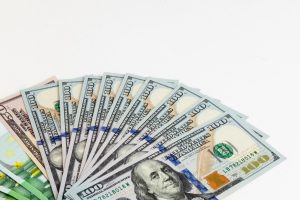US DOLLAR CRUMBLES AS INFLATION COOLS; EURO HITS NEARLY FOUR-YEAR PEAK
The dollar slumped on Thursday, as weaker-than-expected U.S. inflation data for May suggested that the Federal Reserve could resume cutting interest rates sooner rather than later, while the safe-haven yen and Swiss franc benefited from rising Mideast tension. The euro, on the other hand, soared to its highest level in almost four years against the dollar. The greenback also fell to a two-month low versus the Swiss franc and a roughly one-week trough against the yen. Data showed that the U.S. Producer Price Index (PPI) increased less than expected in May, curbed by lower costs for services like air fares, a report that undermined the dollar. Wednesday’s data also indicated cooling inflation, with a lower-than-expected rise in the U.S. Consumer Price Index (CPI). Vassili Serebriakov, FX analyst at UBS in New York, said higher tariffs are not showing just yet on inflation data, although he noted U.S. growth seemed to be slowing. “We already priced in two cuts for the Fed this year, which was less than two last week,” said Serebriakov. “The data is seen as potentially opening the window for the Fed cutting either a little bit sooner or a little bit more.” Futures tracking the Fed’s policy rate showed rising bets the U.S. central bank will deliver a pair of back-to-back interest rate cuts starting in September. Before the data, bets were for a rate cut in September followed by one in December. Following weaker-than-anticipated readings for producer and consumer prices last month, Nomura has revised lower its forecast for the core Personal Consumption Expenditure (PCE) price index, another inflation measure, to 0.169% from its pre-PPI estimate of 0.349%. That pushes the three-month annualized core PCE inflation lower to 1.52%, the lowest since November 2020. “Three consecutive benign readings of monthly core PCE inflation suggest that the underlying inflation trend has decelerated recently,” wrote Nomura in a research note. Thursday’s U.S. data also showed that the number of Americans filing new applications for unemployment benefits was unchanged at higher levels last week, as labor market conditions continued to steadily ease. Investors also rushed into safe-haven assets, with geopolitical risks in focus after U.S. President Donald Trump said some U.S. personnel were being moved out of the Middle East because “it could be a dangerous place” and that Washington would not allow Iran to develop a nuclear weapon. A combination of rising Middle East tensions and concern over the fragility of the U.S.-China trade deal drew investors into safe-haven assets. Analysts noted that the dollar serves as a key barometer of trade talk sentiment, while geopolitical instability prompted investors to buy the Swiss franc and yen. In afternoon trading, the dollar was down more than 1% at 0.8114 Swiss francs, after dropping to 0.8104, the lowest since April 22. The dollar slid 0.7% to 143.59 yen. Earlier in the session, it fell to a one-week low.

STERLING DROPS TO SIX-WEEK LOW AGAINST EURO
Sterling rose against the U.S. dollar on Thursday but dropped to a six-week low against the euro, following weak economic data from the U.S. and the UK. The euro hit its highest level in almost four years against the U.S. currency as investors rushed into safe-haven assets, while remaining cautious about the impact of the U.S.-China trade deal. “Thursday’s data shows the UK economy continues to face challenges,” said Nick Andrews, senior forex strategist at HSBC. “Tuesday’s labour market data also loosened more than expected while Wednesday’s government spending review did little to lift the outlook for growth but instead turned the focus to where potential tax rises might fall in the Autumn.” British government bond yields and the pound dropped on Tuesday after the release of weaker-than-expected labour market data that showed wage growth slowing to its lowest since September 2024, boosting bets on Bank of England rate cuts. The pound fell 0.6% to 85.28 pence per euro after hitting 85.37, its lowest since May 2. Analysts recently flagged that the yield spreads between the UK and the euro area pointed to sterling at 85 pence. The Bank of England meets next week, and although it is expected to stand pat on rates, money market traders added to bets for additional rate cuts this year. Money markets fully priced a 25 basis points BoE rate cut by September and 50 bps by year-end. “We see a strong possibility that the Monetary Policy Committee ditches its hawkish bias, which could pave the way for an August (interest rate) cut,” said Matthew Ryan, head of market strategy at Ebury. The financial market’s reaction to British Finance Minister Rachel Reeves’s plans was muted on Wednesday, as many economists already expected additional taxes later this year. Sterling rose 0.4% versus the dollar to $1.3597 .

STERLING DROPS AS ISRAEL’S STRIKES ON IRAN BOOST SAFE-HAVEN DOLLAR
The pound fell on Friday, in sync with other volatile currencies such as the Australian dollar, after Israel launched a flurry of strikes on Iran, sending investors scurrying into the relative safety of the dollar. Sterling fell almost 0.7% to a low of $1.35225, mirroring the 0.9% declines in the Aussie and New Zealand dollars. The euro meanwhile rose 0.2% against the pound to 85.23 pence. Israel’s strikes targeted nuclear facilities, missile factories and military commanders, and Iranian media and witnesses reported explosions including at the country’s main uranium enrichment facility. Iran launched about 100 drones towards Israeli territory in retaliation, which Israel is working to intercept, Israeli military spokesman Brigadier General Effie Defrin said. Iran has long maintained that its nuclear-related activity is for peaceful purposes. British Prime Minister Keir Starmer said the strikes were concerning and all parties needed to step back and reduce tensions. “Until the danger of further escalation has passed, safe assets are likely to remain in demand,” Commerzbank currency strategist Michael Pfister said. Investors were already on edge this week on lingering concern about the resilience of a U.S.-China trade truce and about the impact of existing tariffs, even those that have been rolled back from April 2’s sky-high levels, on the wider economy. The pound has faced a raft of weak UK data on manufacturing activity, employment and economic growth this week. In addition, finance minister Rachel Reeves announced her spending review, which analysts said did little to improve the outlook for growth but raised the chances of possible tax hikes later this year. Traders expect the Bank of England to deliver another quarter-point rate cut in September and another cut at some point by December, which would bring UK interest rates down to around 3.7%, from 4.25% now.
STOCKS TICK UP BUT DOLLAR HITS 2025 LOW AMID MIXED MACRO SIGNALS
The dollar hit a 2025 low on Thursday but Wall Street stocks held near record highs as traders weighed low inflation readings, rising Middle East tensions, and the fragility of a U.S.-China trade truce. U.S. consumer and producer inflation reports showed overall price pressures remained contained in May, largely due to declines in the cost of gasoline, cars and housing, or services like air transport. But most economists expect inflation to pick up as the impact of U.S. tariffs begins to bite. The dollar, which has lost around 10% in value against a basket of currencies this year, fell to its lowest since April 2022. Global stocks continued an almost-unbroken rally since early April, leaving the MSCI All-Country World index up 0.25%, just below Wednesday’s all-time high. On Wall Street, the Dow Jones Industrial Average added 0.16%, while the S&P 500 and the Nasdaq Composite both gained about 0.3%. Shares of planemaker Boeing lost about 5% after an Air India aircraft carrying more than 200 people crashed in India’s western city of Ahmedabad, and aviation tracking site Flightradar24 said the plane was a Boeing 787-8 Dreamliner. Oracle shares rose nearly 14% after the cloud service provider raised its annual revenue growth forecast. European equities logged their fourth consecutive decline on Thursday as trade optimism waned, with the STOXX 600 down 0.3%. Stocks in China and Hong Kong also fell, led by declines in the tech sector. The U.S. administration said on Wednesday U.S. personnel were being moved out of the Middle East due to heightened regional security risks, which briefly drove oil prices up by 4% before they receded. “(A flare-up in tensions) is a significant tail risk, but I don’t think it is anybody’s baseline forecast. So, it’s something to watch if there is a real escalation there, then markets will take fright and that would have ramifications for the oil price,” Daiwa Capital economist Chris Scicluna said. Iran said it will not abandon its right to uranium enrichment, a senior Iranian official told Reuters on Thursday, adding that a “friendly” regional country had alerted Tehran over a potential military strike by Israel. Classic safe-haven assets got a lift. The Swiss franc and Japanese yen strengthened, pushing the dollar down 1% against the franc and down 0.67% against the yen, while gold rose about 0.9% to $3,382 an ounce. Relief stemming from a positive conclusion to U.S.-China trade talks earlier this week, which President Donald Trump said was a “great deal with China,” evaporated by Thursday.
US DOLLAR LIFTED BY SAFE-HAVEN BIDS AS MIDEAST CONFLICT ESCALATES
The U.S. dollar advanced against major currencies, including the euro and yen, on Friday as markets grabbed safe-haven assets as geopolitical tensions in the Middle East following an Israeli attack on Iran. Israel launched a barrage of strikes across Iran on Friday, attacking nuclear facilities and missile factories and killing a swath of military commanders. In retaliation, Iran’s state news agency IRNA said hundreds of ballistic missiles had been launched. U.S. President Donald Trump, Israel’s main ally, urged Iran to reach a deal on its nuclear program, suggesting that Tehran had brought the attack on itself by resisting a U.S. ultimatum in talks to restrict its uranium enrichment. In afternoon trading, the dollar gained 0.3% to 143.88 against the Japanese yen and rose 0.1% to 0.8110 franc against the Swiss currency , with the greenback on track to snap two straight sessions of losses against safe-haven currencies. “Historically speaking with these kinds of geopolitical events, you get the knee jerk reaction from the market. History tells us to kind of look past a lot of this stuff,” said Jack Janasiewicz, portfolio manager, at Natixis Investment Managers in Boston. “There’s a couple of things worth highlighting. How long does this operation go for? The longer this goes, obviously the worse it gets for confidence and that eventually will start to weigh on the market.” The dollar is still poised for a weekly loss against both the yen and the franc, with markets worried about Trump’s tariffs. The greenback was down nearly 1% versus the yen, on track for its largest weekly fall since mid-May. Against the Swiss franc, the dollar fell for a second straight week. “This (Israel-Iran conflict) just landed on us but the main concern remains tariffs and obstacles to global trade,” said Juan Perez, director of trading at Monex USA in Washington. “When you actually have a physical situation and potential for armed conflict to be prolonged and to escalate, the U.S. dollar and gold jump into safe-haven assets. It’s a bit of a psychological reaction.”

- CAPITALDIGEST MARKET REVIEW , 03/11/2025November 3, 2025
- CAPITALDIGEST DAILY NEWS, 03/11/2025November 3, 2025
- CAPITALDIGEST MARKET REVIEW, 22/09/2025September 22, 2025
Enter your email address for receiving valuable newsletters.
- CAPITALDIGEST DAILY NEWS, 03/11/2025NNPCL WEIGHS OVERHAUL, REPURPOSING OPTIONS FOR REFINERIES The Nigerian National Petroleum Company Limited has said...November 3, 2025
- CAPITALDIGEST MARKET REVIEW, 22/09/2025STERLING RISES AGAINST DOLLAR ON FED-BOE POLICY DIVERGENCE Sterling gained against the dollar on Tuesday,...September 22, 2025
- CAPITALDIGEST DAILY NEWS, 22/09/2025OIL REFORMS DRIVE $18.2BN DEALS – FG Nigeria’s oil and gas sector is experiencing a...September 22, 2025












